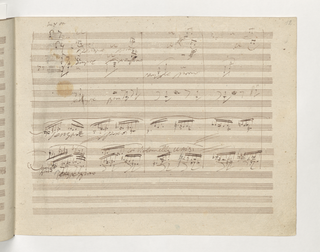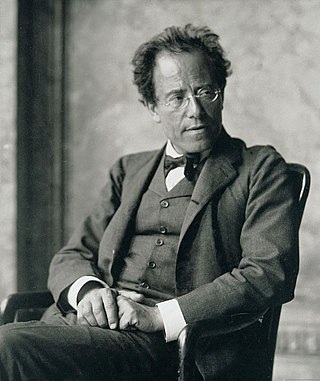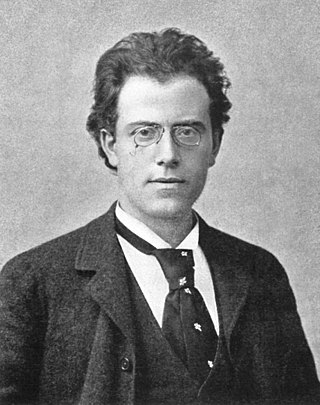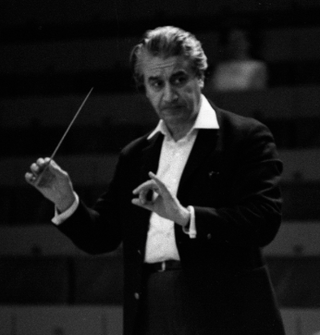Related Research Articles

The Symphony No. 9 in D minor, Op. 125, is a choral symphony, the final complete symphony by Ludwig van Beethoven, composed between 1822 and 1824. It was first performed in Vienna on 7 May 1824. The symphony is regarded by many critics and musicologists as a masterpiece of Western classical music and one of the supreme achievements in the history of music. One of the best-known works in common practice music, it stands as one of the most frequently performed symphonies in the world.

A symphony is an extended musical composition in Western classical music, most often for orchestra. Although the term has had many meanings from its origins in the ancient Greek era, by the late 18th century the word had taken on the meaning common today: a work usually consisting of multiple distinct sections or movements, often four, with the first movement in sonata form. Symphonies are almost always scored for an orchestra consisting of a string section, brass, woodwind, and percussion instruments which altogether number about 30 to 100 musicians. Symphonies are notated in a musical score, which contains all the instrument parts. Orchestral musicians play from parts which contain just the notated music for their own instrument. Some symphonies also contain vocal parts.

Franz Peter Schubert was an Austrian composer of the late Classical and early Romantic eras. Despite his short life, Schubert left behind a vast oeuvre, including more than 600 secular vocal works, seven complete symphonies, sacred music, operas, incidental music, and a large body of piano and chamber music. His major works include the art songs "Erlkönig", "Gretchen am Spinnrade", "Ave Maria"; the Trout Quintet, the unfinished Symphony No. 8 in B minor, the "Great" Symphony No. 9 in C major, the String Quartet No. 14 Death and the Maiden, a String Quintet, the two sets of Impromptus for solo piano, the three last piano sonatas, the Fantasia in F minor for piano four hands, the opera Fierrabras, the incidental music to the play Rosamunde, and the song cycles Die schöne Müllerin, Winterreise and Schwanengesang.

Gustav Mahler was an Austro-Bohemian Romantic composer, and one of the leading conductors of his generation. As a composer he acted as a bridge between the 19th-century Austro-German tradition and the modernism of the early 20th century. While in his lifetime his status as a conductor was established beyond question, his own music gained wide popularity only after periods of relative neglect, which included a ban on its performance in much of Europe during the Nazi era. After 1945 his compositions were rediscovered by a new generation of listeners; Mahler then became one of the most frequently performed and recorded of all composers, a position he has sustained into the 21st century.
The Berlin Philharmonic is a German orchestra based in Berlin. It is one of the most popular, acclaimed and well-respected orchestras in the world.

The Symphony No. 2 in C minor by Gustav Mahler, known as the Resurrection Symphony, was written between 1888 and 1894, and first performed in 1895. This symphony was one of Mahler's most popular and successful works during his lifetime. It was his first major work that established his lifelong view of the beauty of afterlife and resurrection. In this large work, the composer further developed the creativity of "sound of the distance" and creating a "world of its own", aspects already seen in his First Symphony. The work has a duration of 80 to 90 minutes, and is conventionally labelled as being in the key of C minor; the New Grove Dictionary of Music and Musicians labels the work's tonality as C minor–E♭ major. It was voted the fifth-greatest symphony of all time in a survey of conductors carried out by the BBC Music Magazine.

The Symphony No. 9 by Gustav Mahler was written between 1908 and 1909, and was the last symphony that he completed. A typical performance takes about 75 to 90 minutes. A survey of conductors voted Mahler's Symphony No. 9 the fourth greatest symphony of all time in a ballot conducted by BBC Music Magazine in 2016. As in the case of his earlier Das Lied von der Erde, Mahler did not live to see his Symphony No. 9 performed.

Sergiu Celibidache was a Romanian conductor, composer, musical theorist, and teacher. Educated in his native Romania, and later in Paris and Berlin, Celibidache's career in music spanned over five decades, including tenures as principal conductor of the Munich Philharmonic, Berlin Philharmonic, Sicilian Symphony Orchestra and several other European orchestras. Later in life, he taught at Mainz University in Germany and the Curtis Institute of Music in Philadelphia, Pennsylvania.
Symphony No. 9 most commonly refers to:

Kurt Magnus Atterberg was a Swedish composer and engineer. He is best known for his symphonies, operas, and ballets.
An unfinished symphony is a fragment of a symphony, by a particular composer, that musicians and academics consider incomplete or unfinished for various reasons. The archetypal unfinished symphony is Franz Schubert's Symphony No. 8, written in 1822, six years before his death. It features two fully orchestrated movements. While it seems clear from sketches that Schubert set out to create a traditional four-movement symphony, this has been the subject of endless debate. Schubert wrote the symphony for the Graz Musical Society, and gave the manuscript to his friend Anselm Hüttenbrenner, in his capacity as its representative. However, Hüttenbrenner did not show the score to the society at that time, nor did he reveal the existence of the manuscript after Schubert died in 1828, but kept it a secret for another 37 years. In 1865, when he was 76, Hüttenbrenner finally showed it to the conductor Johann von Herbeck, who conducted the extant two movements on 17 December 1865 in Vienna, adding the last movement of Schubert's third symphony as the finale. Music historians and scholars then toiled to "prove" the composition was complete in its two-movement form, and indeed, in that form it became one of the most popular pieces in the late 19th century classical music repertoire, and remains one of Schubert's most popular compositions.
D minor is a minor scale based on D, consisting of the pitches D, E, F, G, A, B♭, and C. Its key signature has one flat. Its relative major is F major and its parallel major is D major.

William Steinberg was a German-American conductor.

Franz Schalk was an Austrian conductor. From 1918 to 1929 he was director of the Vienna State Opera, a post he held jointly with Richard Strauss from 1919 to 1924. He was later involved in the establishment of the Salzburg Festival.

Manfred Honeck is an Austrian conductor. He is currently the music director of the Pittsburgh Symphony Orchestra.

The Vienna Singverein is the concert choir of the Vienna Musikverein with around 230 members. It is regularly requested by top orchestras and conductors for large and varied projects.
The Austrian composer Anton Bruckner composed eleven symphonies, the first, the Symphony in F minor in 1863, the last, the unfinished Ninth symphony from 1893 to 1896.
References
- 1 2 3 4 5 Roberts, Maddy (January 30, 2019). "What is the Curse of the Ninth - and does it really exist". Classic Fm. Archived from the original on 2019-06-07. Retrieved June 27, 2021.
- ↑ "The Curse of the Ninth Haunted These Composers | WQXR Editorial". WQXR. 17 October 2016. Archived from the original on 2022-01-16. Retrieved 2022-01-16.
- ↑ Ethan Mordden, A Guide to Orchestral Music: The Handbook for Non-Musicians. New York: Oxford University Press (1980): 312. ISBN 9780198020301. "Though it is more a song-cycle than a symphony, this was to have been Mahler's Ninth Symphony—but superstition cautioned him. Beethoven and Schubert both died after completing their respective Ninths, and Bruckner died with his Ninth unfinished. ... He thought he saw a way out: give his Ninth Symphony a name—no number—thus leaping the verge unscathed. He could then go on to a "tenth" (really his Tenth). But fate laughed at Mahler, and he, like his predecessors, died before he could complete a Tenth Symphony."
- ↑ Roberts, Maddy Shaw. "What is the Curse of the Ninth – and does it really exist?". Classic FM. Archived from the original on 7 June 2019. Retrieved 17 January 2023.
- ↑ James, Bennett II (17 October 2016). "The Curse of the Ninth Haunted These Composers". The WQXR Newsletter. New York Public Radio. Archived from the original on 17 January 2023. Retrieved 17 January 2023.
- ↑ "Arnold Complete Symphonies". Gramophone. Mark Allen Group. Archived from the original on 17 January 2023. Retrieved 17 January 2023.
- ↑ "Kurt Atterberg". Classical Net. Archived from the original on 17 January 2023. Retrieved 17 January 2023.
- ↑ Maslanka, Matthew. "Symphony No. 10: The River of Time". David Maslanka. Maslanka Press. Archived from the original on 17 January 2023. Retrieved 17 January 2023.
- ↑ "Recordings of Vincent Persichetti". Naxos. Naxos Digital Services Ltd. Archived from the original on 17 January 2023. Retrieved 17 January 2023.
- ↑ "Principal Works". The Roger Sessions Society. Archived from the original on 1 January 2023. Retrieved 17 January 2023.
- ↑ "BORIS TISHCHENKO (1939-2010): Symphony No. 8 (World Premiere Recording), Concerto for Violin, Piano and String Orchestra, 3 Songs to Poems of Marina Tsvetayeva (arr. Leonid Rezetdinov [b.1961])". Records International. Archived from the original on 30 July 2023. Retrieved 30 July 2023.
- ↑ Guardian Staff (2012-02-05). "Pass notes No 3,119: Curse of the ninth symphony". the Guardian. Archived from the original on 2022-01-16. Retrieved 2022-01-16.
- ↑ Street, Joan. "The Curse Of The Ninth: Series 19, Episode 6". Midsomer Murders. Archived from the original on 2021-11-27. Retrieved 2022-01-14.